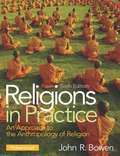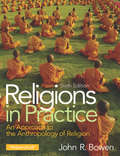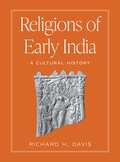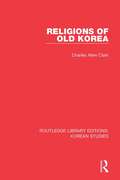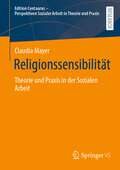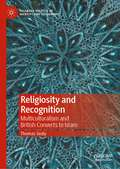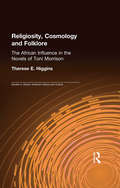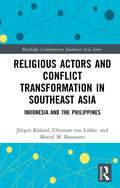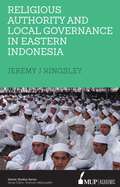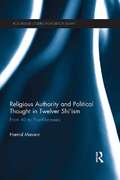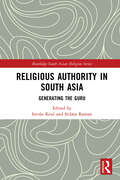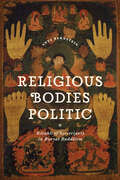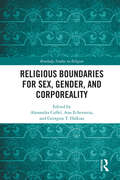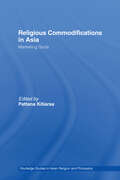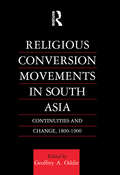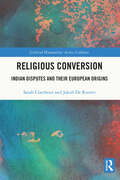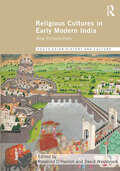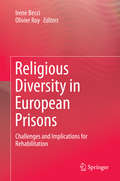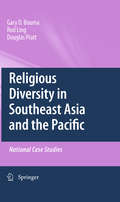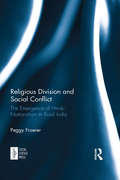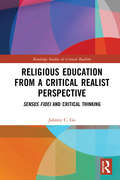- Table View
- List View
Religions in Practice (Sixth Edition)
by John R. BowenExamines religious practices from an anthropological perspective, Religions in Practice, 6/e, offers an issues-oriented perspective on everyday religious behaviors - prayer, sacrifice, initiation, healing, etc. - by focusing on such topics as transnationalism, gender, and religious laws. The text examines a full spectrum of religions, from small-scale societies to major, established religions. The in-depth treatment of Islam, Hinduism, and Christianity is particularly noteworthy and easily supplemented with field projects directly related to the text. MySearchLab is a part of the Bowen program. Research and writing tools, including access to academic journals, help students explore religion in even greater depth. To provide students with flexibility, students can download the eText to a tablet using the free Pearson eText app. NOTE: MySearchLab does not come automatically packaged with this text. To purchase the text with MySearchLab, order the package ISBN: 0205961045 / 9780205961047 Religions in Practice Plus MySearchLab with Pearson eText -- Access Card Package Package consists of: 0205239927 / 9780205239924 MySearchLab with Pearson eText -- Valuepack Access Card 0205917666 / 9780205917662 Religions in Practice
Religions in Practice: An Approach to the Anthropology of Religion
by John R. BowenExamines religious practices from an anthropological perspectiveReligions in Practice, 6/e, offers an issues-oriented perspective on everyday religious behaviors - prayer, sacrifice, initiation, healing, etc. - by focusing on such topics as transnationalism, gender, and religious laws. The text examines a full spectrum of religions, from small-scale societies to major, established religions. The in-depth treatment of Islam, Hinduism, and Christianity is particularly noteworthy and easily supplemented with field projects directly related to the text.
Religions of Early India: A Cultural History
by Richard H. DavisThe extraordinary multiplicity of religions and religious cultures in India, chronicled over two thousand yearsFrom its earliest recorded history, India was a place of remarkable and varied religious activity, ranging from elaborate sacrificial rituals and rigorous regimes of personal austerity to psycho-spiritual experimentation and utopian visions. In this ambitious and wide-ranging chronicle, Richard Davis offers a history of India&’s myriad religious cultures that spans two thousand years, from 1300 BCE to 700 CE. India, Davis writes, was not only the birthplace of the religions we now know as Hinduism, Buddhism, and Jainism. It was also the home of other, often unnamed religions that can be classified as &“folk&” or &“popular&” religions. Tracing these intertwined practices, Davis shows that the ardent and heterogeneous religious cultures of early India came to define and redefine themselves in relation to one another.Davis recounts this history through voices—voices recorded in hymns, poems, songs, didactic stories, epic narratives, scientific treatises, and theological discourses, as well as voices that speak through material remains, whether monumental sculptures or tiny terracotta figurines of nameless goddesses. He focuses on the long millennium often designated as &“classical India,&” which stretches from the time of the founding figures of Buddhism and Jainism during the sixth century BCE through the seventh-century-CE dynasties of the Chalukyas and the Pallavas in southern India. Throughout, he emphasizes encounter, interaction, debate, critique, and borrowing among religious communities within a shared, changing social and political reality. The voices and visions of early India&’s religions, Davis shows us, are fascinating in their multiplicity.
Religions of Old Korea (Routledge Library Editions: Korean Studies #6)
by Charles Allen ClarkThis book, first published in 1932, was written by a Western expert on Korea, and was the first to thoroughly investigate and document the old religious practices of Korea. No book like this could be written again from original sources, for all of the data has passed away, and archival records are not necessarily complete. It is a key text in the study of Korean religion.
Religions of the Ancient Near East
by Daniel C. SnellThis book is a history of religious life in the Ancient Near East from the beginnings of agriculture to Alexander the Great's invasion in the 300s BCE. Daniel C. Snell traces key developments in the history, daily life and religious beliefs of the people of Ancient Mesopotamia, Egypt, Israel and Iran. His research investigates the influence of those ideas on the West, with particular emphasis on how religious ideas from this historical and cultural milieu still influence the way modern cultures and religions view the world. Designed to be accessible to students and readers with no prior knowledge of the period, the book uses fictional vignettes to add interest to its material, which is based on careful study of archaeological remains and preserved texts. The book will provide a thoughtful summary of the Ancient Near East and includes a comprehensive bibliography to guide readers in further study of related topics.
Religionssensibilität: Theorie und Praxis in der Sozialen Arbeit (Edition Centaurus - Perspektiven Sozialer Arbeit in Theorie und Praxis)
by Claudia MayerDas Verhältnis von Religion und Sozialer Arbeit ist schwierig. Einerseits zeigen sich klare Tendenzen der Tabuisierung und Distanzierung von Religion in der Sozialen Arbeit. Andererseits ist die faktische Präsenz von Religion in sozialen Kontexten nicht in Abrede zu stellen. Um angesichts dieses Spannungsverhältnisses den professionellen Umgang mit dem religiösen Phänomen in der Sozialen Arbeit zu gewährleisten, ist eine theoretische Fundierung notwendig. Ausgehend vom Begriff der Religionssensibilität wird das Materialobjekt Religion auf der Basis religionstheoretischer Erkenntnisse als objektive Religion und subjektive Religiosität geklärt. Ergänzt wird dies durch eine Auseinandersetzung mit dem Begriff der Sensibilität als Modus des Umgangs mit dem Materialobjekt, der sich in die Dimensionen von ‚sensibel umgehen mit...‘ und ‚sensibilisieren für...‘ ausdifferenzieren lässt. Im Ergebnis zeigt sich: Eine religionssensible Soziale Arbeit geht sensibel mit Religion und Religiosität um und sie sensibilisiert für Religion und Religiosität. Der professionelle Umgang mit dem religiösen Phänomen gelingt durch den Übertrag dieser Dimensionen in die Praxis und (Aus-)Bildung Sozialer Arbeit.
Religiosity and Recognition: Multiculturalism and British Converts to Islam (Palgrave Politics of Identity and Citizenship Series)
by Thomas SealyThis book argues that multiculturalism remains a relevant and vital framework through which to understand and construct inclusive forms of citizenship. Responding to contemporary ethnic and religious diversity in European states and the position of religious minorities, debates in multiculturalism have revitalized discussion of the public role of religion, yet multiculturalism has been increasingly challenged in both political as well as academic circles. With a focus on Britain and through a study of the narratives of British converts to Islam, this book engages in debates centered around multiculturalism, particularly on the issues of identity, recognition, and difference. Yet, it also identifies and interrogates multiculturalism’s shortcomings in relation to specifically religious identities and belonging. In a unique and innovative analysis, this book combines a discussion of multiculturalism in Britain with insights from political theology. It juxtaposes multiculturalism’s concepts of ethno-religious identity and recognition with the notions of religiosity and hospitality to offer a new perspective on religious identity and the implications of this for thinking with and about multiculturalism and multicultural social and political relations.
Religiosity, Cosmology and Folklore: The African Influence in the Novels of Toni Morrison (Studies in African American History and Culture)
by Therese E. HigginsFirst published in 2003. Routledge is an imprint of Taylor & Francis, an informa company.
Religious Actors and Conflict Transformation in Southeast Asia: Indonesia and the Philippines (Routledge Contemporary Southeast Asia Series)
by Jürgen Rüland Marcel Baumann Christian Von LübkeDrawing on a rich body of multimethod field research, this book examines the ways in which Indonesian and Philippine religious actors have fostered conflict resolution and under what conditions these efforts have been met with success or limited success. <P><P>The book addresses two central questions: In what ways, and to what extent, have post-conflict peacebuilding activities of Christian churches contributed to conflict transformation in Mindanao (Philippines) and Maluku (Indonesia)? And to what extent have these church-based efforts been affected by specific economic, political, or social contexts? Based on extensive fieldwork, the study operates with a nested, multi-dimensional, and multi-layered methodological concept which combines qualitative and quantitative methods. Major findings are that church-based peace activities do matter, that they have higher approval rates than state projects, and that they have fostered interreligious understanding. <P><P>Through innovative analysis, this book fills a lacuna in the study of ethno-religious conflicts. Informed by the novel Comparative Area Studies (CAS) approach, this book is strictly comparative, includes in-case and cross-case comparisons, and bridges disciplinary research with Area Studies. It will be of interest to academics in the fields of conflict and peacebuilding studies, interreligious dialogue, Southeast Asian Studies, and Asian Politics.
Religious Authority and Local Governance in Eastern Indonesia
by Jeremy J KingsleyReligion plays a key role in everyday affairs in Indonesia—including governance at the local, regional and national level. This book investigates the local governance landscape of the world's largest Muslim majority state, Indonesia, by providing a detailed account of local communities and religious authority on the eastern Indonesian island of Lombok—one of the nation's most pious areas. In particular, this book considers the interaction of state and non-state actors and institutions and how these institutions are interwoven into a fabric of governance. Through an ethnographic case study of an Islamic boarding school, Darul Falah, and the community committed to it, this book trains its focus upon local Muslim religious leaders (Tuan Guru) who are central to local governance. Drawing upon the notion of the fabric of governance, this book shows how governance is woven from multiple strands, which are made up of a combination of institutions, rules and actors to be interpreted within dynamic social, legal and political processes. In doing so, this book employs a new means to theorise governance frameworks and understand how religion and governance are tightly intertwined. Religious Authority and Local Governance in Eastern Indonesia seeks to re-orient discussions of Indonesian political and legal affairs from the ground up and use local governance as a means to speak to larger social, legal and political issues. Islamic Studies Series - Volume 25
Religious Authority and Political Thought in Twelver Shi'ism: From Ali to Post-Khomeini (Routledge Studies in Political Islam)
by Hamid MavaniRanging from the time of the infallible Imams, to the contemporary era, this book provides a comprehensive overview of Shi’i religious and political authority, focusing on Iran and Lebanon, without limiting the discourse to Khomeini’s version of an Islamic State. Utilising untapped Arabic and Persian sources, Hamid Mavani provides a detailed, nuanced, and diverse theoretical discussion on the doctrine of leadership (Imamate) in Shi’ism from traditional, theological, philosophical, and mystical perspectives. This theoretical discussion becomes the foundation for an analysis of the transmission of the Twelfth Imam’s religious and political authority vis-á-vis the jurists during his Greater Occultation. Bringing the often overlooked diversity within the Shi’i tradition into sharp focus, Religious Authority and Political Thought in Twelver Shi’ism discusses what constitutes an Islamic state, if there is such a notion as an Islamic state. Hamid Mavani further explores the possibility of creating a space for secularity, facilitating a separation between religion and state, and ensuring equal rights for all. This book argues that such a development is only possible if there is a rehabilitation of ijtihad. If this were to materialise modern religious, social, economic, political, and cultural challenges could be addressed more successfully. This book will be of use to scholars and students with interests ranging from Politics, to Religion, to Middle East Studies.
Religious Authority in South Asia: Generating the Guru (Routledge South Asian Religion Series)
by István Keul Srilata RamanThis book focuses on genealogies of religious authority in South Asia, examining the figure of the guru in narrative texts, polemical tracts, hagiographies, histories, in contemporary devotional communities, New Age spiritual movements and global guru organizations. Experts in the field present reflections on historically specific contexts in which a guru comes into being, becomes part of a community, is venerated, challenged or repudiated, generates a new canon, remains unique with no clear succession or establishes a succession in which charisma is routinized. The guru emerges and is sustained and routinized from the nexus of guruship, narratives, performances and community. The contributors to the book examine this nexus at specific historical moments with all their elements of change and contingency. The book will be of interest to scholars in the field of South Asian studies, the study of religions and cultural studies.
Religious Bodies Politic: Rituals of Sovereignty in Buryat Buddhism (Buddhism and Modernity)
by Anya BernsteinReligious Bodies Politic examines the complex relationship between transnational religion and politics through the lens of one cosmopolitan community in Siberia: Buryats, who live in a semiautonomous republic within Russia with a large Buddhist population. Looking at religious transformation among Buryats across changing political economies, Anya Bernstein argues that under conditions of rapid social change—such as those that accompanied the Russian Revolution, the Cold War, and the fall of the Soviet Union—Buryats have used Buddhist “body politics” to articulate their relationship not only with the Russian state, but also with the larger Buddhist world. During these periods, Bernstein shows, certain people and their bodies became key sites through which Buryats conformed to and challenged Russian political rule. She presents particular cases of these emblematic bodies—dead bodies of famous monks, temporary bodies of reincarnated lamas, ascetic and celibate bodies of Buddhist monastics, and dismembered bodies of lay disciples given as imaginary gifts to spirits—to investigate the specific ways in which religion and politics have intersected. Contributing to the growing literature on postsocialism and studies of sovereignty that focus on the body, Religious Bodies Politic is a fascinating illustration of how this community employed Buddhism to adapt to key moments of political change.
Religious Boundaries for Sex, Gender, and Corporeality (Routledge Studies in Religion)
by Alexandra Cuffel Ana Echevarria Georgios T. HalkiasThe ambiguity concerning the interpretation of the ‘physical body’ in religious thought is not peculiar to any given religion, but is discernible in the scriptures, practices, and disciplines in most of the world’s major religious traditions. This book seeks to address the nuances of difference within and between religious traditions in the treatment and understanding of what constitutes the body as a carrier of religious meaning and/or vindication of doctrine. Bringing together an international team of contributors from different disciplines, this collection addresses the intersection of religion, gender, corporeality and/or sexuality in various Western and Eastern cultures. The book analyses instances when religious meaning is attributed to the human body’s physicality and its mechanics in contrast to imagined or metaphorical bodies. In other cases, it is shown that the body may function either as a vehicle or a hindrance for mystical knowledge. The chapters are arranged chronologically and across religious orientations, to offer a differentiated view on the body from a global perspective. This collection is an exciting exploration of religion and the human body. As such, it will be of great interest to scholars in religious studies, theology, Islamic studies, South Asian studies, history of religions and gender studies.
Religious Change In Zambia
by VanPublished in 1981, Religious Change in Zambia is a valuable contribution to the field of Middle East Studies.
Religious Commodifications in Asia: Marketing Gods
by Pattana KitiarsaThis book addresses the growing academic concerns of the market-religion convergences in Asia. Bringing together a group of leading scholars from Asia, Europe, Australia and North America, it discusses multiple issues regarding religious commodifications and their consequences across Asia’s diverse religious traditions. Covering key issues in the anthropology and sociology of contemporary Asian religion, it draws theoretical implications for the study of religions in the light of the shift of religious institutions from traditional religious beliefs to material prosperity. The fact that religions compete with each other in a ‘market of faiths’ is also at the core of the analysis. The contributions show how ordinary people and religious institutions in Asia adjusted to, and negotiated with, the penetrative forces of a global market economy into the region’s changing religio-cultural landscapes. An excellent contribution to the growing demands of ethnographically and theoretically updated interpretations of Asian religions, Religious Commodifications in Asia will be of interest to scholars of Asian religion and new religious movements.
Religious Conversion Movements in South Asia: Continuities and Change, 1800-1990
by Geoffrey OddieThis text examines examples of religious conversion throughout South Asia including: Processes of Conversion of Christianity in 19th Century NW IndiaIslamic Conversion in South IndiaKartabhaja Converts to Evangelical Christianity in BengalCentral Kerala Dalit ConversionFrench Mission and Mass MovementsConversion and Non-Conversion Experiences; and more. This book is a significant addition to the growing tradition of scholarship on religious conversion and a valuable resource for scholars and students who are interested in religious, social, and cultural developments of South Asia.
Religious Conversion: Indian Disputes and Their European Origins (Critical Humanities Across Cultures)
by Jakob De Roover Sarah ClaerhoutThis book re-examines the issue of religious conversion, which has been a site of conflict in India for several centuries. It discusses wide-ranging themes such as conversion, education, and reform in colonial India; the process and practices of conversion in Christian Europe; Gandhi, conversion, and the equality of religions; perspectives from Hindu nationalism, secularism and religious minorities; religious freedom and the limits of propagating religion; and conversion in constitutional law, commissions, and courts, to chart new directions for research on religion, tradition, and conversion. Tracing developments from the 19th-century colonial era to contemporary times, the book analyses cultural background frameworks and the origins of religious conversion and its conceptualisation in Western Christianity. It further delves into how Indian culture and its traditions have shaped responses to conversion. Part of the Critical Humanities Across Cultures series, this book will be useful to scholars and researchers of critical humanities, religion, cultural studies, sociology of religion, comparative religion, philosophy, anthropology, theology, Indology, history, politics, postcolonial studies, critical theory, and South Asian studies.
Religious Cultures in Early Modern India: New Perspectives (Routledge South Asian History and Culture Series)
by Rosalind O’Hanlon and David WashbrookReligious authority and political power have existed in complex relationships throughout India’s history. The centuries of the ‘early modern’ in South Asia saw particularly dynamic developments in this relationship. Regional as well as imperial states of the period expanded their religious patronage, while new sectarian centres of doctrinal and spiritual authority emerged beyond the confines of the state. Royal and merchant patronage stimulated the growth of new classes of mobile intellectuals deeply committed to the reappraisal of many aspects of religious law and doctrine. Supra-regional institutions and networks of many other kinds - sect-based religious maths, pilgrimage centres and their guardians, sants and sufi orders - flourished, offering greater mobility to wider communities of the pious. This was also a period of growing vigour in the development of vernacular religious literatures of different kinds, and often of new genres blending elements of older devotional, juridical and historical literatures. Oral and manuscript literatures too gained more rapid circulation, although the meaning and canonical status of texts frequently changed as they circulated more widely and reached larger lay audiences.Through explorations of these developments, the essays in this collection make a distinctive contribution to a critical formative period in the making of India’s modern religious cultures.This book was published as a special issue of South Asian History and Culture.
Religious Difference in a Secular Age: A Minority Report
by Saba MahmoodHow secular governance in the Middle East is making life worse—not better—for religious minoritiesThe plight of religious minorities in the Middle East is often attributed to the failure of secularism to take root in the region. Religious Difference in a Secular Age challenges this assessment by examining four cornerstones of secularism—political and civil equality, minority rights, religious freedom, and the legal separation of private and public domains.Drawing on her extensive fieldwork in Egypt with Coptic Orthodox Christians and Bahais—religious minorities in a predominantly Muslim country—Saba Mahmood shows how modern secular governance has exacerbated religious tensions and inequalities rather than reduced them. Tracing the historical career of secular legal concepts in the colonial and postcolonial Middle East, she explores how contradictions at the very heart of political secularism have aggravated and amplified existing forms of Islamic hierarchy, bringing minority relations in Egypt to a new historical impasse. Through a close examination of Egyptian court cases and constitutional debates about minority rights, conflicts around family law, and controversies over freedom of expression, Mahmood invites us to reflect on the entwined histories of secularism in the Middle East and Europe.A provocative work of scholarship, Religious Difference in a Secular Age challenges us to rethink the promise and limits of the secular ideal of religious equality.
Religious Diversity in European Prisons
by Olivier Roy Irene BecciThis book examines how prisons meet challenges of religious diversity, in an era of increasing multiculturalism and globalization. Social scientists studying corrections have noted the important role that religious or spiritual practice can have on rehabilitation, particularly for inmates with coping with stress, mental health and substance abuse issues. In the past, the historical figure of the prison chaplain operated primarily in a Christian context, following primarily a Christian model. Increasingly, prison populations (inmates as well as employees) display diversity in their ethnic, cultural, religious and geographic backgrounds. As public institutions, prisons are compelled to uphold the human rights of their inmates, including religious freedom. Prisons face challenges in approaching religious plurality and secularism, and maintaining prisoners' legal rights to religious freedom. The contributions to this work present case studies that examine how prisons throughout Europe have approached challenges of religious diversity. Featuring contributions from the UK, France, Italy, Germany, Switzerland, The Netherlands, Belgium and Spain, this interdisciplinary volume includes contributions from social and political scientists, religion scholars and philosophers examining the role of religion and religious diversity in prison rehabilitation. It will be of interest to researchers in Criminology and Criminal Justice, Social and Political Science, Human Rights, Public Policy, and Religious Studies.
Religious Diversity in Post-Secular Societies: Conceptual Foundations, Public Governance and Upcoming Prospects (Boundaries of Religious Freedom: Regulating Religion in Diverse Societies)
by Zakaria Sajir Rafael Ruiz AndrésThis book offers a multidisciplinary exploration of one of the defining characteristics of post-secular societies: religious diversity. Drawing from the sociology of religion, the sociology of migration, and related fields, it critically examines the interaction between religion, diversity, and secular governance, challenging conventional approaches to managing pluralism in contemporary contexts. Organized into three sections, the book explores: Theoretical and Conceptual Foundations: Establishing core frameworks for understanding post-secularization, pluralistic societies, and the intricate dynamics between religion and diversity. Regulating Religion in Postsecular and Diverse Societies: Analyzing policy innovation, comparative case studies, and practical challenges in managing religious diversity within secular governance structures. Navigating the Future: Prospects and Challenges of Diversity Governance in Post-Secular Contexts: Addressing emerging trends such as digital transformations, the politicization of religious identities, and the evolving role of religious traditions in fostering inclusivity and resilience. Featuring contributions from leading scholars and emerging researchers, this volume provides a multidimensional perspective on debates spanning sociology, anthropology, law, and public policy. Through socio-historical examples and case studies, it examines pressing topics such as religious pluralism in secular governance, diversity management strategies, and the transformative impact of digital technologies on religious expression. At its core, the book is framed by two key concepts: post-secularization and diversity. It reexamines religion&’s evolving role in secularized societies, taking religious plurality—not the disappearance of religion—as a starting point for exploring secularity. This work is an essential resource for students, researchers, educators, policymakers, and professionals seeking actionable insights into critical debates on religion, migration, diversity, and secular governance in today&’s globalized and digitalized world.
Religious Diversity in Southeast Asia and the Pacific
by Gary D. Bouma Rodney Ling Douglas PrattReligious diversity is now a social fact in most countries of the world. While reports of the impact of religious diversity on Europe and North America are reasonably well-known, the ways in which Southeast Asia and Asia Pacific are religiously diverse and the ways this diversity has been managed are not. This book addresses this lack of information about one of the largest and most diverse regions of the world. It describes the religious diversity of 27 nations, as large and complex as Indonesia and as small as Tuvalu, outlining the current issues and the basic policy approaches to religious diversity. Southeast Asia and the Pacific Islands are portrayed as a living laboratory of various religious blends, with a wide variance of histories and many different approaches to managing religious diversity. While interesting in their own right, a study of these nations provides a wealth of case studies of diversity management - most of them stories of success and inclusion.
Religious Division and Social Conflict: The Emergence of Hindu Nationalism in Rural India
by Peggy FroererThis book is an ethnographic account of the emergence of Hindu nationalism in a tribal (adivasi) community in Chhattisgarh, central India. It is argued that the successful spread of Hindu nationalism in this area is due to the involvement of the Rashtriya Swayamsevak Sangh (RSS), a militant Hindu nationalist organization, in local affairs. While active engagement in 'civilizing' strategies has enabled the RSS to legitimize its presence and endear itself to the local community, the book argues that participation in more aggressive strategies has made it possible for this organization to fuel and attach local tensions to a broader Hindu nationalist agenda.
Religious Education from a Critical Realist Perspective: Sensus Fidei and Critical Thinking (Routledge Studies in Critical Realism)
by Johnny C. GoThis book examines the possibility and necessity of critical thinking in religious education through the lenses of critical realism and the Christian doctrine of sensus fidei (‘sense of faith’). Drawing on Bhaskar’s original critical realism and data from a survey of over a thousand teachers in the Philippines, the author argues for a view of critical thinking based on components of ‘disposition’ and ‘competence’. As such, critical thinking becomes the expression of a commitment to judgemental rationality and, in a Christian religious education, is guided by the individual’s sensus fidei. A philosophical and theological discussion of the process of coming to know in the religious domain, Religious Education from a Critical Realist Perspective also offers concrete recommendations on how to promote the practice of religious critical thinking in confessional religious education classrooms. As such, it will appeal to scholars of philosophy, theology and pedagogy with interests in religious education and curriculum development.
